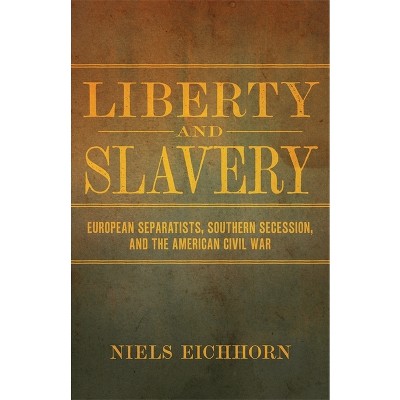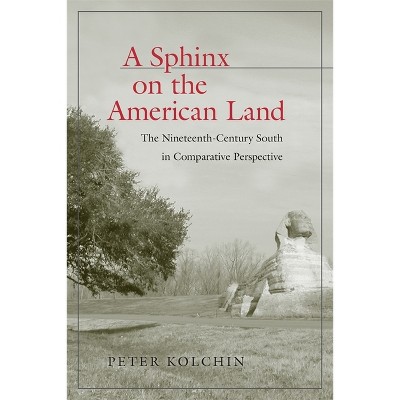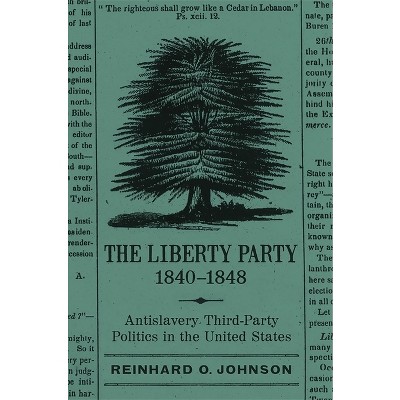$49.99 sale price when purchased online
$50.00 list price
Target Online store #3991
About this item
Highlights
- In Sweet Land of Liberty, Tom Sancton examines how the French left perceived and used the image of the United States against the backdrop of major historical developments in both countries between the Revolution of 1848 and the Paris Commune of 1871.
- About the Author: Tom Sancton, former Paris bureau chief for Time magazine, holds a doctorate in history from Oxford University and is the author of numerous books.
- 336 Pages
- History, United States
Description
About the Book
"In "Sweet Land of Liberty," Tom Sancton traces the arc of the American image in the eyes of the French left against the backdrop of the major historical developments in both countries between the Revolution of 1848 and the Paris Commune of 1871. Along the way, Sancton weaves in the voices of scores of French observers, known and unknown, including Alexis de Tocqueville, Victor Hugo, George Sand, Louis Blanc, Alphonse de Lamartine, Jules Michelet, Auguste Blanqui, Pierre-Joseph Proudhon, Elisâee Reclus, Lâeon Gambetta, and Georges Clemenceau. The French left-broadly speaking, those who embraced the ideals of liberty and popular government-were naturally drawn to the American example as both an inspiration and a propaganda tool in their battle against the authoritarian government of Napolâeon III. Throughout the 1850s, however, the United States was not acting much like a positive model: rapacious expansionism, slavery, and sectional frictions tarnished its image and diminished its usefulness. The Civil War marked a critical turning point: while the Emperor toyed with the idea of a joint Anglo-French recognition of the Confederacy and launched his ill-fated Mexican adventure, his opponents on the left feared the collapse of the great American experiment in popular government-the famous "proposition" voiced by Lincoln in the Gettysburg Address. The Emancipation Proclamation, the Union victory, and Lincoln's martyrdom sparked a powerful burst of pro-Americanism on the French left that intensified in the final years of the Imperial regime. At no previous time had the American image been extolled so fervently by French liberals and progressives. As Sancton points out, however, the infatuation was short-lived. Following the Franco-Prussian War, the bloody suppression of the Commune, and the founding of the conservative Third Republic, the usefulness and relevance of the American example waned in the eyes of the French left. Meanwhile, the corruption, excesses, and vulgarity of Gilded Age America fed an increasingly negative image that laid the groundwork for the anti-Americanism that became a tenet of the French left in the 20th century. Among its original contributions to French and American scholarship on this period, Sancton's study explodes the widespread myth that French workers, despite the distress caused by the cotton famine, steadfastly supported the North during the Civil War out of a sense of solidarity with American slaves. On the contrary, most workers wanted the war to end as soon as possible, urged French government intervention, and many were favorable to the South. More broadly, his analysis shows how the American example, though useful to the left as a propaganda tool, was poorly understood and, in fact, ill-adapted to French republican traditions rooted in the Great Revolution. For all the ritual evocations of Lafayette and the "traditional Franco-American friendship," the two republics evolved in very different directions after 1871"--Book Synopsis
In Sweet Land of Liberty, Tom Sancton examines how the French left perceived and used the image of the United States against the backdrop of major historical developments in both countries between the Revolution of 1848 and the Paris Commune of 1871. Along the way, he weaves in the voices of scores of French observers--including those of everyday French citizens as well as those of prominent thinkers and politicians such as Alexis de Tocqueville, Victor Hugo, and Georges Clemenceau--as they looked to the democratic ideals of their American counterparts in the face of rising authoritarianism on the European continent.
Louis Napoleon's bloody coup in December 1851 disbanded France's Second Republic and ushered in an era of increased political oppression, effectively forging together a disparate group of dissidents who embraced the tradition of the French Revolution and advocated for popular government. As they pursued their opposition to the Bonapartist regime, the French left looked to the American example as both a democratic model and a source of ideological support in favor of political liberty. During the 1850s, however, the left grew increasingly wary of the United States, as slavery, rapacious expansionism, and sectional frictions tarnished its image and diminished its usefulness. The Civil War, Sancton argues, marked a critical turning point. While Napoleon III considered joint Anglo-French recognition of the Confederacy and launched an ill-fated invasion of Mexico, his opponents on the left feared the collapse of the great American experiment in democracy and popular government. The Emancipation Proclamation, the Union victory, and Lincoln's assassination ignited powerful pro-American sentiment among the French left that galvanized their opposition to the imperial regime. After the fall of the Second Empire and the founding of the conservative Third Republic in 1870, the relevance of the American example waned. Moderate republicans no longer needed the American model, while the more progressive left became increasingly radicalized following the bloody repression of the Commune in 1871. Sancton argues that the corruption and excesses of Gilded Age America established the groundwork for the anti-American fervor that came to characterize the French left throughout much of the twentieth century. Sweet Land of Liberty counters the long-held assumption that French workers, despite the distress caused by a severe cotton famine in the South, steadfastly supported the North during the Civil War out of a sense of solidarity with American slaves and lofty ideas of liberty. On the contrary, many workers backed the South, hoped for an end to fighting, and urged French government intervention. More broadly, Sancton's analysis shows that the American example, though useful to the left, proved ill-adapted to French republican traditions rooted in the Great Revolution of 1789. For all the ritual evocations of Lafayette and the "traditional Franco-American friendship," the two republics evolved in disparate ways as each endured social turmoil and political upheaval during the second half of the nineteenth century.Review Quotes
A remarkable book which will be of considerable interest to historians of both 19th France and America....In 1848, the French left thought of the USA as a sister republic. In the 1850's, French leftists saw it as a crudely materialist, slave society which reminded them of the France of Napoléon le petit. Lincoln's death in 1865, and the Paris Commune of 1871, changed all that, but not for long...The chapters I most enjoyed dealt with French and British working-class views of the American Confederacy. The book is very well written and is something of a page turner. Sancton's account of the Trent episode in 1861 makes for a very good read.--Patrice Higonnet, Harvard University, author of "Sister Republics: The Origins of French and American Republicanism"
Almost from the moment America won its independence, French attitudes toward the U.S. have fluctuated between hope and disappointment, envy and resentment. In the 19th century, no sector of French opinion registered these swings more faithfully than the engaged left. In expertly mapping the sudden shifts of left-leaning opinion from the 1848 Revolution through the Second Empire, Tom Sancton tosses in an extra bonus for the general reader--a smart and lucid guide to the forked road of French politics during these confusing years. This is a very fine book.--Lawrence Powell, Tulane University, author of "The Accidental City: Improvising New Orleans"
History and politics don't respect national borders, which is why American historians and believers in "American exceptionalism" both need to read this book. In Sweet Land of Liberty, Tom Sancton offers a compelling argument that 19th-century American politics and ideologies make better sense in the context of larger political currents swirling around the Atlantic World. But he also offers a timely case study in how political activists can selectively "perceive ... a foreign power in the light of [their] own [national] culture and ideology." The narrow focus in this briskly-written book is French politics in the decades around the American Civil War; the big picture continues to be the fate of liberty and democracy in modern societies.--Philip M. Katz, author of "From Appomattox to Montmartre: Americans and the Paris Commune"
About the Author
Tom Sancton, former Paris bureau chief for Time magazine, holds a doctorate in history from Oxford University and is the author of numerous books. He is currently a research professor at Tulane University.Dimensions (Overall): 9.0 Inches (H) x 6.0 Inches (W) x .88 Inches (D)
Weight: 1.46 Pounds
Suggested Age: 22 Years and Up
Number of Pages: 336
Genre: History
Sub-Genre: United States
Publisher: LSU Press
Format: Hardcover
Author: Tom Sancton
Language: English
Street Date: April 14, 2021
TCIN: 1004455252
UPC: 9780807174302
Item Number (DPCI): 247-23-4750
Origin: Made in the USA or Imported
Shipping details
Estimated ship dimensions: 0.88 inches length x 6 inches width x 9 inches height
Estimated ship weight: 1.46 pounds
We regret that this item cannot be shipped to PO Boxes.
This item cannot be shipped to the following locations: American Samoa (see also separate entry under AS), Guam (see also separate entry under GU), Northern Mariana Islands, Puerto Rico (see also separate entry under PR), United States Minor Outlying Islands, Virgin Islands, U.S., APO/FPO
Return details
This item can be returned to any Target store or Target.com.
This item must be returned within 90 days of the date it was purchased in store, shipped, delivered by a Shipt shopper, or made ready for pickup.
See the return policy for complete information.












